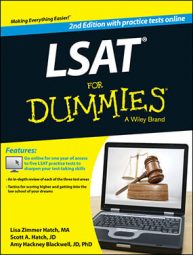One type of question you will find on the LSAT involves reading comprehension. These questions may require you to read two passages and answer questions about both reading selections. Try a few.
Reading comprehension sample questions
The following questions refer to the following two passages. The first is adapted from Managing Nonprofit Organizations, by Mary Tschirhart and Wolfgang Bielefeld (Wiley). The second is adapted from The Handbook of Nonprofit Governance, by BoardSource (Wiley).
Passage A
Leaders and managers of nonprofits face a variety of challenges. One of the most important is to keep the mission in mind in all decision making. Nonprofits must operate to fulfill their mission and are limited in their engagement in activities far afield from it. In addition they must keep in mind that the real owner of a nonprofit is the public.
It is the public to whom they are ultimately accountable.
There are no designated shareholders or owners to please. Nonprofits are subject to the claims, and possible control, of many stakeholders, including donors, clients, board members, staff, volunteers, government at all levels, and community members. The expectations of these stakeholders can vary widely and leaders must balance competing demands.
Lester Salamon and others describe a number of additional challenges. Many nonprofits face fiscal difficulties, some starting with government cutbacks in the 1980s in areas where nonprofits were active. Government assistance has become more targeted and tied to stricter requirements. Not all nonprofits experiencing losses in government funding have been able to offset those losses with growth in private giving or earned income.
There is growing competition as more for-profits move into areas traditionally served by nonprofits, such as health care, higher education, and employment training. The rise of B corporations, which are required to make decisions good for society, not just their shareholders, adds to the continuing erosion of sector boundaries.
In addition nonprofits are under pressure from funders who are demanding more evidence that the nonprofits they fund are making a measurable positive impact, with some funders seeing themselves as investors with rights to influence strategic decisions.
Passage B
Nonprofits are not immune from damage that can be caused by unscrupulous and fraudulent solicitors, financial improprieties, and executives and board members who care more about their own financial welfare than the mission of the organization.
Problems, when they do arise, are particularly disturbing because of the nature of nonprofits themselves — organizations created to provide some public benefit. Most people are familiar with the mechanisms that safeguard the integrity of government and business.
Disenchanted voters can throw politicians out of office, and the branches of government view each other with watchful eyes. Businesses have shareholders or owners and are monitored by government agencies such as the Securities and Exchange Commission and the Occupational Safety and Health Administration. The media monitor both sectors and are quick to point out cases of corruption and poor performance.
Far fewer people understand how nonprofits are monitored and regulated. For much of its history, the nonprofit sector has operated outside the realm of harsh public scrutiny. No government agency exists exclusively to monitor the activities of nonprofits, most nonprofits aren't required to hold public meetings, and few journalists report on nonprofits with the same depth and focus devoted to business and government.
Nevertheless, nonprofits have many lines of defense against fraud and corruption. For example, all nonprofits are governed by a board of directors or trustees (there's no real difference) — a group of volunteers that is legally responsible for making sure the organization remains true to its mission, safeguards its assets, and operates in the public interest. The board is the first line of defense against fraud and abuse.
The authors of the two passages share a concern that
(A) for-profit business are moving in on areas traditionally served by nonprofit organizations
(B) no government or regulatory agency exists with the sole purpose of monitoring the activities of nonprofit organizations
(C) investors desire to see measurable results from the money they commit to nonprofit organizations
(D) nonprofits may face difficulties staying true to their overall mission
(E) nonprofit board members sometimes have their own financial interests at heart instead of those of the nonprofit
Which of the following titles would most appropriately fit both passages?
(A) Managing the Nonprofit Sector: An Overview
(B) The Funding Crisis within the Nonprofit Sector
(C) Balancing the Mission of a Nonprofit with the Mission of Funders
(D) The Board: A Nonprofit's First Line of Defense
(E) A Brief History of the Nonprofit Sector
Which of the following claims about nonprofit management is NOT made by the author of Passage B?
(A) There are very few individuals who are familiar with the controls that govern nonprofits.
(B) There is no legitimate distinction between a director who sits on a nonprofit board and a trustee.
(C) Nonprofits are not governed by a major regulating body or bodies as most businesses are.
(D) Challenges facing nonprofits are exacerbated by the fact that they are organizations intended to serve the public good.
(E) Nonprofits lack a strong defense against corruption and fraud.
Which of the following provides a statement with which the authors of both passages would agree?
(A) Nonprofits are dealing with an influx of for-profit agencies occupying roles once traditionally served by the nonprofit sector.
(B) Many nonprofits that have experienced a loss of government funding have been unable to offset those losses with earned income or private donations.
(C) Fiscal difficulties for many nonprofits stem from a period of heavy government cutbacks that took place in the 1980s.
(D) The public should hold managers, leaders, and boards of nonprofit organizations liable for their decisions.
(E) An organization's stakeholders include donors, clients, volunteers, and community members.
Answers
D
A
E
D

